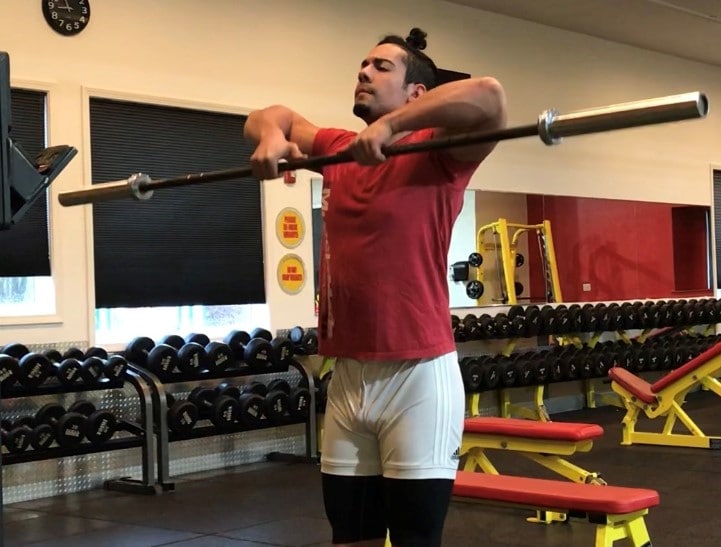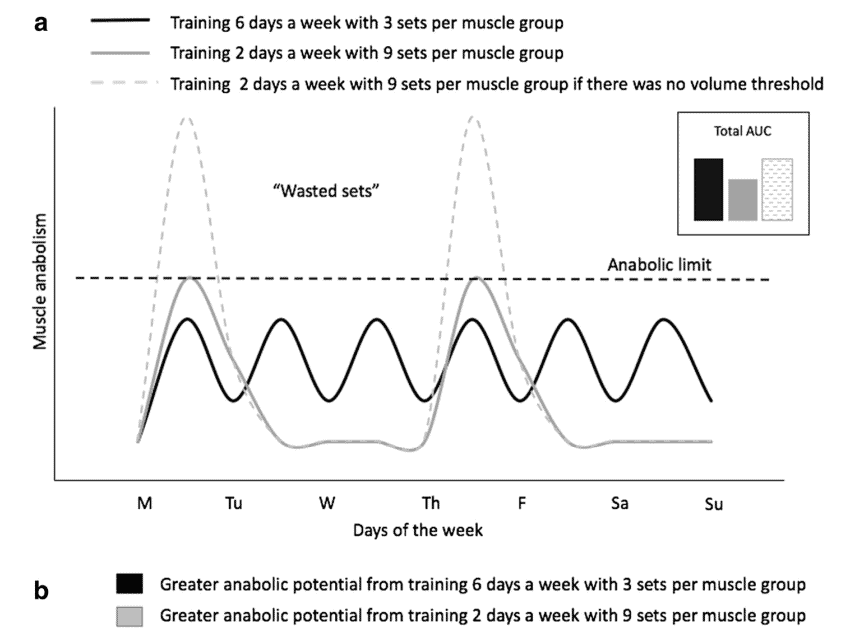
“What are you working out today?”
“Chest.”
“How about you?”
“Arms.”
But is chest day the best way to build as much muscle as possible? Intuitively, when most of us start training, we go the bro split route. Bro split basically means you dedicate an entire workout to one or two muscles at the most and hit those muscles just once per week. An example is outlined below.
Monday: Chest
Tuesday: Back
Wednesday: Arms
Thursday: Off
Friday: Shoulders
Saturday: Legs
Sunday: Off
Pretty typical routine, it may even look similar to yours right now. You can have a lot of success with a routine like this. I did a bro split for many years and put on a good amount of muscle. Hell I took the bro split to a new level, having separate days for biceps and triceps! It turned out okay but I always felt the other body parts were playing catch up as time went on, particularly chest.
Research suggests that workout volume is the biggest factor in muscle growth, and high frequency training has a SLIGHT advantage over low frequency training.
As time passed I learned the benefits of higher frequency training. High frequency training means you work a muscle or muscle group multiple times per week. I won’t lie and say I didn’t have my doubts when I first started. What I had been doing up to that point was working. Naturally we like to stick with what we’re comfortable with, but comfort and building muscle don’t exactly go hand in hand. As you’ll discover in this article, your training habits may need to change as you become more advanced.
Please note that the information below applies to intermediate and advanced trainees. This is not to demean beginners or untrained individuals, it is due to the fact that they would respond positively to any training stimulus and that these methods wouldn’t make much of a difference.
Progressive Overload and Training Volume
The principle of progressive overload is one that we are all familiar with, whether you know the fancy technical phrase or not. It simply means increasing weight lifted, sets, reps, or training frequency in order to continue making progress. This is the case for both muscle building, which is discussed in this article, and strength training.
Training volume can be measured in multiple ways. The most common is by multiplying weight lifted x reps x sets. Another way to measure volume is by counting the number of working sets for each body part. A working set is simply one you would deem challenging, and not a warm up. Although total working sets seems like an informal measure, it may actual be a more accurate indicator of volume. The reason is because you can fudge your training volume by doing a ton of reps with very light weight. Although that is technically a lot of volume, it completely takes intensity out of the equation, which is an important factor for hypertrophy (building muscle). There is a certain threshold of weight that you need for an exercise in order to stimulate muscle fibers for growth. You can’t just do 100 curls with 5lb dumbbells.
As you can see, progressive overload and training volume are not mutually exclusive terms. In fact, you can say training volume is a component of progressive overload. They are both important factors in muscle growth. Studies show that volume is the main driver of muscle growth, however the design with many of these studies can leave a bit to be desired.
Most studies compare one set of an exercise to say, three sets. It’s pretty obvious that three sets would elicit more growth than one. But what about three sets compared to six, or ten, or twenty? At a certain point the law of diminishing returns would take effect, particularly within the context of a singular workout. This is where the bro split may fall short. Your muscle growth potential would be capped at a certain point if you’re just chasing volume in a 60-90 minute chest workout. Eventually you would be performing sets that your body cannot respond to, nor recover adequately from.
High volume training is definitely a good thing, but in my opinion it should be performed within a program utilizing greater training frequency. Look at it this way; at a certain point your anabolic response to a workout is maximized. At what point depends on the individual, but just understand that at a certain point in the workout you will have reached your maximum anabolic potential. This is similar to the way protein synthesis is maximized in a meal containing about 30-40 grams of protein. More is not detrimental, but does not necessarily provide greater benefit.
If volume is equal, we can potentially derive greater gains from a high frequency program. The graph below from an S. J. Dankel et al. research article illustrates this nicely. Like we mentioned, there is a point at which your anabolic response to a workout is capped. Anything above that they refer to as “wasted sets.” If instead you perform multiple workouts, with less volume per muscle group per workout, you would potentially experience a greater net anabolic effect because there are no wasted sets. The overall volume over the course of the week is the same, but the training frequency is different.

So That Means Full Body Workouts Every Day?
Not exactly. Even at lower volumes per muscle group, full body workouts can be very taxing. Since we still need to keep volume at a certain level, you may have to do 4-5 full body workouts per week to reach it. Some people can do this and be perfectly fine, but if you’re used to a bro split then this could be a rough transition. Even if full body training would technically be the best method, you have to be practical. Assess your current training routine and lifestyle to see what’s best. A push/pull/legs or upper/lower routine would still allow you to increase training frequency while getting proper recovery.
A concern with people using a bro split is that they would not be able to reach their normal training volume when moving to high frequency training. Instead of doing a chest workout consisting of 6 or 7 exercises, now they would be doing 1 or 2 exercises multiple times per week. That just feels wrong! But high frequency training can actually lead to greater volume and higher quality workouts. Consider the following example:
Person A performs a chest workout consisting of four sets of four exercises; flat bench press, incline bench press, cable crossovers, and incline dumbbell flyes.
Person B performs four sets of those same exercises, but spread over the course of the week.
In the example of Person A, by the time they get to those incline dumbbell flyes they will be fatigued. They will either use a lighter weight or use a normal weight but fail to hit their target rep count. Person B is less likely to experience this muscle fatigue because they’ve worked all muscles equally. Thus they will be able to use a heavier weight and give maximum effort for each set. Over time, Person B’s training intensity and training volume (remember that weight lifted is a component of volume) will be greater than Person A and they should experience better results.
You could also consider the opposite scenario. Person A knows they have a long chest workout ahead of them, so they play it safe in the early stages of the workout. They leave a little too much in the tank whether its in the form of weight lifted or total reps. Person B doesn’t have to consider this. They’re only doing one or two exercises per body part so there’s no sense in trying to conserve energy. They can go all out for each set knowing that the next exercise is a completely different (and fresh) muscle.
Another thing to consider is that advanced trainees need a greater training frequency due to a natural reduction in protein synthesis. When you are a beginner, your muscle protein synthesis levels after a workout can be elevated for up to 72 hours! This is basically 72 hours of opportunity to grow if your diet and sleep are straight. As you become more advanced, that window closes. Advanced trainees may reach a point where their protein synthesis is elevated for less than 24 hours after a workout.
The easiest way to combat this is to train at a higher frequency. It doesn’t make sense to train chest or legs once a week if muscle protein synthesis is only elevated for a short time. You need to train those muscles more often to create more spikes in protein synthesis and more opportunities to grow. Even if you don’t go to full body training, you still can design a program to hit each muscle two or three times per week.
High Frequency Training Split Examples
Push/Pull/Legs
Monday: Push (Chest, Triceps, Shoulders)
Tuesday: Pull (Back, Biceps, Forearms)
Wednesday: Legs
Thursday: Off
Friday: Push
Saturday: Pull
Sunday: Legs
Upper/Lower
Monday: Upper Strength (Low Rep, Heavy)
Tuesday: Lower Strength (Low Rep, Heavy)
Wednesday: Upper Hypertrophy (Moderate Rep, Moderate Weight)
Thursday: Off
Friday: Lower Hypertrophy (Moderate Rep, Moderate Weight)
Saturday: Full Body Endurance (High Rep, Lighter Weight)
Sunday: Off
As you can see in the Upper/Lower example, we took it a step further and added some periodization as well, changing the rep range in each workout. I go into more detail about periodization in this article.
With all this being said, it is important to note that training volume still seems to be the primary factor when building muscle. You should never sacrifice volume for high frequency training.
There are so many variables you can change when it comes to training, but some of the take home points from this article are listed below
- Training volume and progressive overload are the two biggest factors for muscle growth. Although training frequency was the subject of this article, it is still secondary to volume.
- At a certain point in the workout, one has maximized the anabolic response from said workout and anything beyond that is essentially a “waste.”
- Higher training frequency can ensure maximum anabolic response from each workout while also getting the benefit of working the muscle multiple times per week
- Advanced trainees have a shorter muscle protein synthesis response from a workout, and thus should train with higher frequency
Recent Posts
Stretching Before Workouts: Essential Warmup or Performance Killer
“Don’t stretch before workouts, your muscles become too supple” “Stretch before your workouts, warming up is important” It's conflicting advice like this that drives people crazy,...
Best Protein Bar For the Money | Cost Effective, High Quality
Protein bars are no longer a supplement dedicated to diehard gym rats, with awful taste and the consistency of a brick. Men, women, and even teenagers can commonly be seen eating protein bars. The...
